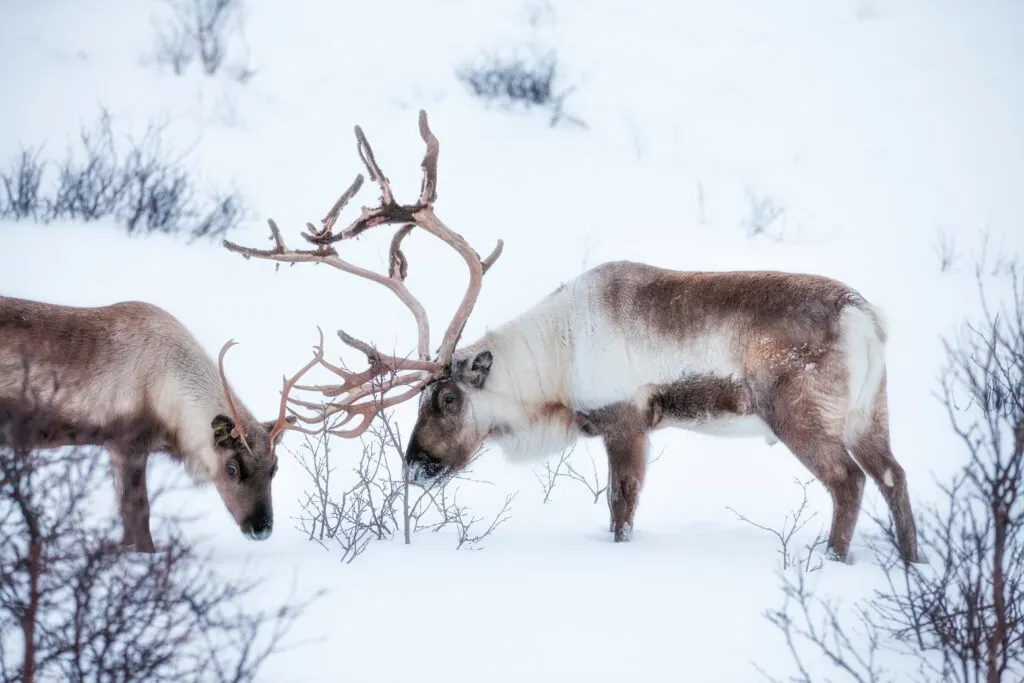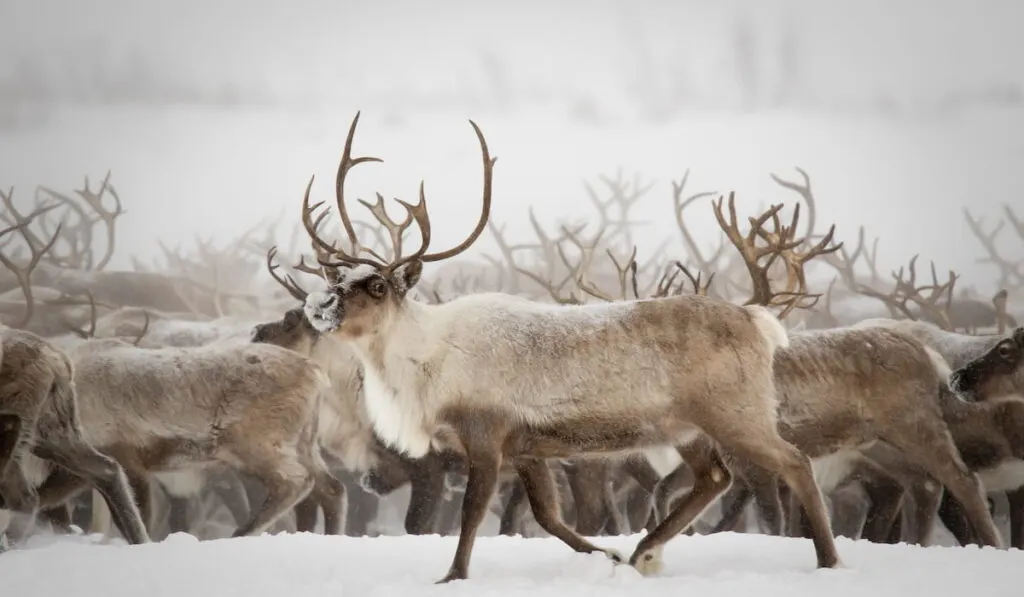Reindeer belong to the deer clan; primarily found in the Arctic Region, highlands of Russia, North of China, Canada and Alaska. These parts of the world are famous for their cruel and cold climatic conditions, to which this animal adapts very well. A lot of native tribes till today which lives in these regions hunt the reindeer for their food and clothing requirements.
Do Reindeer Have Tails? Yes, reindeer have a short, white-colored tail similar to that of a deer. The color of the tail matches the colour of the reindeer’s neck.

Reindeer are considered to be the toughest species of the deer family. The whole world lovingly knows them as Santa Claus’ sled pullers.
Table of Contents
7 Fun- Facts About Reindeer
1. There are 2 names for this species.
Did you know that reindeer have another name? They are also called Caribou.
There are various animals that are initially wild but over a period of time have become domesticated.
A reindeer which is found in the forest is called Caribou. The Caribou, or the wild version of the reindeer, is found in the forests of North America.
When we domesticate them, they tend to all go by the same name: “reindeer”. The similarities of their physical and scientific characteristics confirm the reindeer and caribou are just different names for the same animal.
2. Both Girls and Boys have Antlers
Reindeer antlers look like branches of a tree. These branch-like horns usually adorn the male member’s head of the deer clan.
These antlers comprise of horn which are grown and shed all in the course of a year. In fact, this is the only subspecies of the deer herd, where both the female and male members have antlers.
The males shed their antlers by the month of December, whereas the females take a bit longer and shed their antlers after the mating season.
It is believed that a male reindeer’s antlers can measure up to 51inches compared to the females whose horns do not grow more than 20inches.
The horns of the males are much bigger and beautiful than his female counterparts. Because the antlers are made of bone, they are frightfully heavy and sharp making it a weapon for defense against their natural predators like Polar Bears and Brown Bears.
The females use their antlers as a shovel, to shuffle snow in the winters to look for food!

The male reindeer weighs between 140 – 550 lbs, this weight is enough for them to clear the snow during winters. The bigger the antler’s the more attractive the male reindeer becomes for their female counterparts.
There is a competition among the male reindeers to attract the female reindeer’s attention. The fitness of the male reindeer is judged by the size of the antlers it grows every year!
3. Feet That Change With Weather
Have you ever heard of an animal whose feet change according to the weather conditions around it? The reindeer has this unique ability, where its hooves have a soft padded sponge on top during the summer, which help them walk on the slippery and wet surface.
Come winter, the sponge padding automatically shrinks exposing the hoof, which in turn helps the reindeer dig their feet deep into the snow providing secure footing.
In addition to being able to walk in the deep snow, these hooves also help the reindeers dig through the snow for food during harsh and snowy winters.
4. Ultra Violet Vision
It is said that the vision of a reindeer ranges from a normal vision to ultraviolet vision! Generally, snow and ice are UV reflective, whereas urine, predators, and lichens absorb all the ultraviolet rays!
Against the white background of ice, it is easy for a reindeer to spot urine –which may indicate the presence of its natural predators! Also because of this kind of gifted vision, a reindeer can look for lichen easily through the snow for winter food!
5. Red-Nosed Reindeer
For years children across the world sing “Rudolph! The red-nosed reindeer had a very shiny nose”! This is practically true about our reindeer that pulls Santa’s Sleigh during Christmas!
The reindeer is said to have 25% more of red blood vessels in their nose area. They have curly thin bones inside their nostrils which in the science world are called “Nasoturbinal Bones”.
The soft and thin tissues of these bones are supplied with blood vessels, which help in warming the cold air that the reindeer breathes in before it reaches the lungs.
The reason why if closely noticed the nose of the reindeer during the harsh winters look red due to the presence of blood vessels in them. These bones also moisturize the dry icy air on their way in and dry up the moisture of the air that the reindeer breathes out!
6. They Like to Hang Out with Friends

Reindeers are said to be social creatures like us humans! They travel in herds which can be as small as 10 members to a bigger herd of over 50,000 reindeer.
Reindeers travel together to fend off their natural predators the Polar Bear and Brown Bears. It is believed that lesser mosquitoes are found at heights, making it mandatory for these reindeer to climb highlands during the summer months to fend off the stingy insects.
Reindeer travel the longest distance to migrate during the summer months. They can travel for hundreds of miles during the year in search of food.
Their antlers are very strong and make them very good swimmers. They have to swim across icy lakes when they migrate.
Reindeer are also said to be very fast runners! It is said that the reindeer’s run about 30 miles per day when migrating and their speed can go up to 50 miles per hour!
There is a clicking sound of the knees when some species of the reindeer’s travel, this sound helps the group stay together when traveling through snowstorms on the mountains.
7. Baby Reindeer Can Walk Within Hours of Birth
The mating season for reindeers is between September and November. The male reindeers compete with each other and the winning male gets to mate with almost 15-20 females!
The female carries her baby for 7 months. Once the calf is out, within a few minutes it starts walking!
This calf is an independent individual by the age of 2 years and does not require the mother being around.
Reindeers are an important part of our ecosystem and our culture. Their continuous foraging and excreta help the soil gain the necessary nutrients. They have been a part of the culture and are pets of a lot of native European tribes. Reindeer will always be a part of our Christmas celebrations and children will usually be introduced to them through “Rudolph, The Red-Nosed Reindeer!”
